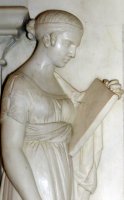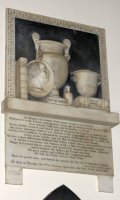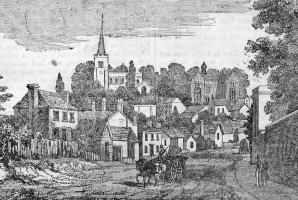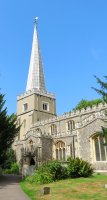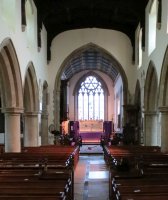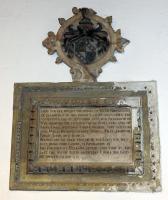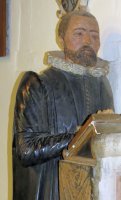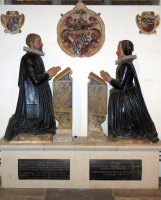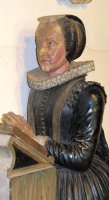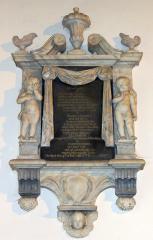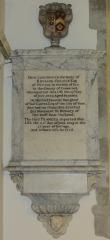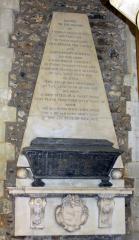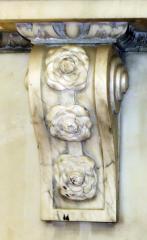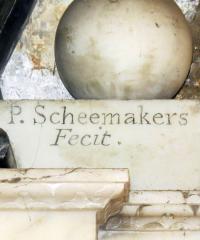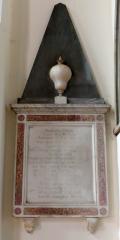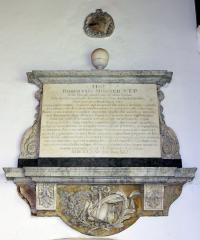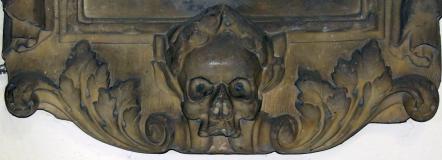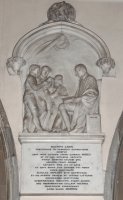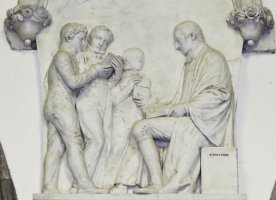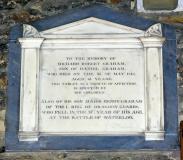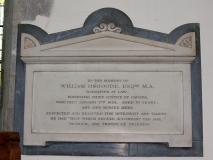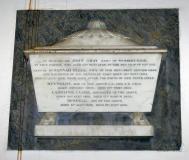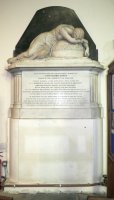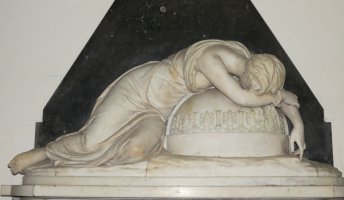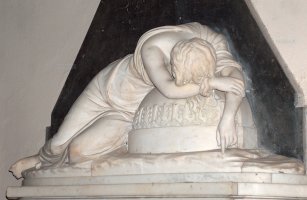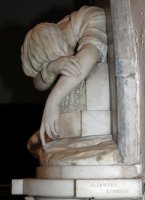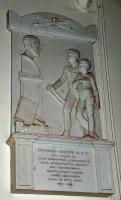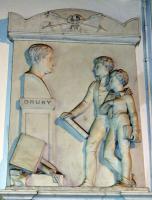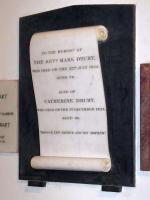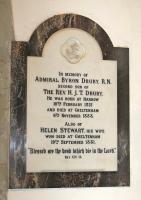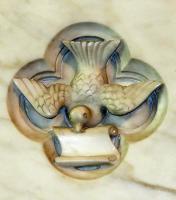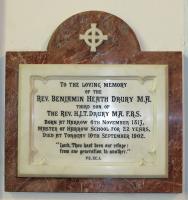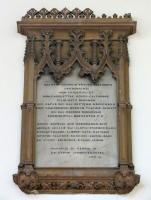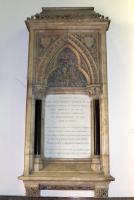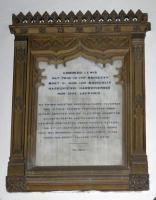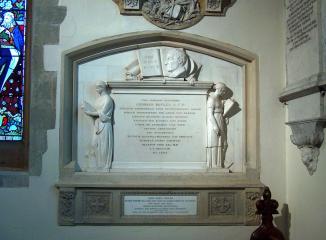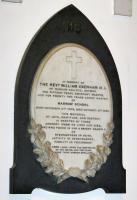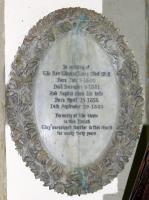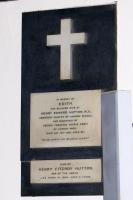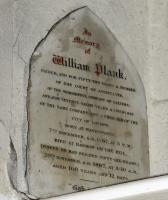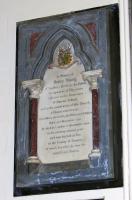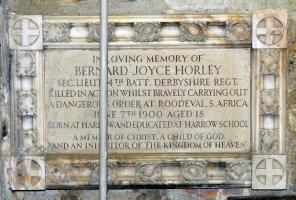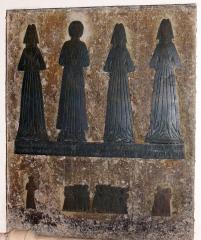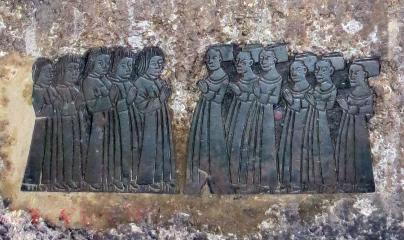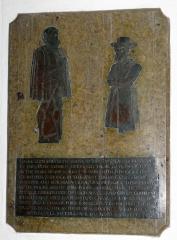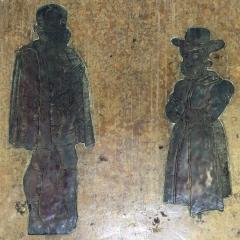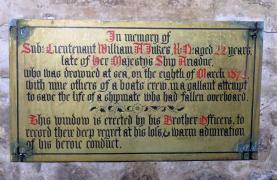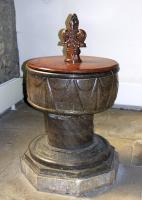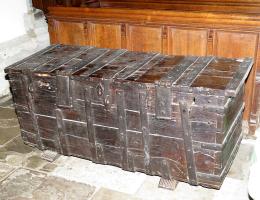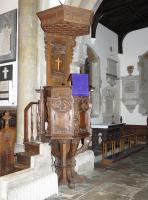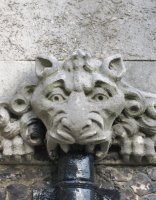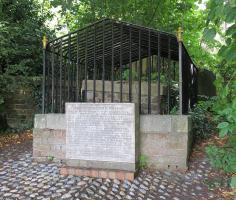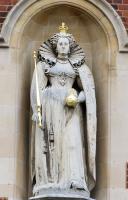Harrow on the Hill, St Mary's Church - Monuments
St Mary's Church, Harrow on the Hill contains a good crop of 18th and 19th Century wall panel monuments including several good figure pieces with important sculptors represented, a pair of kneeling statues from a 17th Century monument, and several brasses, all in an ambient medieval interior. Outside, the hilltop position gives the visitor the same splendid view as enjoyed by the young Byron, there is an evocative churchyard, and the streets around are a pleasant mix of largely 19th Century and 18th Century buildings, centred of course on Harrow School. If you want the 10-minute visit version of this page, click here.
Harrow on the Hill Parish Church, dedicated to St Mary, is in a perfect position, at the top of Harrow Hill, and its spire is a landmark for many miles around. It is ancient: the West Tower is largely of the mid-12th Century (the upper part and spire more recent), and the body of the Church from the early 13th Century, with additions in the 15th Century, including a splendid 15th Century ceiling with the supporting posts borne on strangely carved heads. Then there were the usual Victorian restorations, most notably by Gilbert Scott, no less, in 1846-9, rather drastic, but apparently necessary after the end of the 18th Century had seen the Church in a dilapidated state. Recent work on the plumbing found the Saxon grave of a young woman, evidence of a pre-Norman ecclesiastical existence.
Harrow on the Hill: Parish Church of St Mary.
The monuments are significant. In all there are about 40-odd panels and a few other entirely plain plaques. They include the remains of one large kneeler monument, five wall monuments with figure sculpture, and others with minor sculpture. We see grander 18th Century Classical panels and obelisks, white-on-black panels from the early 19th Century and several Gothic revival pieces with sandstone rather than marble surrounds, and a few turn-of-the-19th Century panels which see the return of coloured marbles and alabaster. The artists include the important sculptors Peter Scheemakers, John Flaxman, and Richard Westmacott the Younger, and also work by the less well known but noteworthy sculptors and stonemasons Peter Turnerelli, Humphrey Hopper, Gaffin of Regent Street, and M.W. Johnson. A separate page is devoted to the churchyard monuments, and there is also a 10-minute visit version of this page.
Monuments
William Gerrard, d.1584, 'late of the Flamberds'.
Gerrard [Gerard] monuments, 16-17th Centuries
- William Gerrard, d.1584, "late of Flamberds in this parish", and his wife Dorothe, d.1583, and three of their many children. Pinkish alabaster panel, with carved border inside an outer frame with repeating patterns. On top rests a painted shield of arms with carved helm and mantling within a circlet with decorative embellishments. There may once have been more.
- William Gerard, d.1609, put up by his son, Gilbert Gerard.
The principle ancient monument in the Church. It consists of a pair of large kneeling figures, of Gilbert Gerard and his unnamed wife. Each wears a painted black robe, and has a large ruff at the neck, smaller ones at the cuff. They kneel praying in the usual fashion, each with a faldstool or prayer desk in front, draped and with floral carving at the base. The remains of the cushions on which they sit survive, the inscribed black panels, and three painted coats of arms with surrounding carving, but the rest of the monument is lost. Once there would have been a canopy, supported on pillars to the sides, and a sideboard like structure underneath, here replaced by a modern one. William Gerard is middle aged,
broad faced and with a fairly full beard. His wife is thinner, grimmer, and has swept-back hair under a headpiece. For more on kneeler monuments in general, see this page.
William Gerard, d.1609, and wife, typical kneeler monument.
18th Century monuments
- Edward Waldo, d.1707, erected by his third wife, Elizabeth [Shuckburgh] Waldo. A Classical Baroque piece, with the black central panel having the inscription surrounded by knotted drapes, nicely carved, mourning cherubs standing to the sides against the shafts of receding pilasters, a broken curly (swan-necked) pediment above. Within the pediment stands a corrugated funereal urn, and to the sides are shell-shaped lamps. At the base, two extravagantly large brackets, with clustered flowers beneath, and a central apron with a blank roundel which once would have contained painted heraldic arms.
Beneath this is a winged cherub head (see this page for lots of such things).
Classical panels of the early 17th C: Waldo and Colvile.
- Richard Colvile, d.1723, erected by his wife Frances [Carter] Colvile, d.1729. Well cut script on a pale beige marble panel, with hefty mantelpiece-like surround of streaky black and white marble. At the top is a cartouche of arms, carved and painted, and at the base a deep apron, with blank central slab, side pieces carved with leaves, gadrooning below, and a final terminus carved as a winged cherub head.
- Thomas Graham, d.1733, 'Apothecary to their Majesties King George the I and II, and Apothecary General to the Army', and his wife Anne Graham, d.1724. The first of several monuments to the Graham family in Harrow Church. A tall obelisk monument. The centrepiece of the monument is a black casket, seen side-on, standing on moulded feet and with a moulded lid. Above and behind it rises the obelisk, standing on two balls, unusual in being cut in white marble rather than dark, and in bearing
the long inscription rather than that being on a panel below. The casket rests on a shelf,
supported on scrolled brackets bearing carved flowers, and with a central cartouche of arms.
It is signed prominently by the important sculptor Peter Scheemakers, who had a penchant for casket-and-obelisk monuments.
Peter Scheemakers' obelisk to Thomas Graham, d.1733, and details.
- Anne Manners, d.1739, in her 18th year. Seemingly cut from a single piece of stone, the inscribed panel is bordered by a drape knotted at the top sides, and hanging freely down, with a winged cherub head above, and below, a skull with a leafy crown (see this page if you like skulls), flanked by Acanthus leaves to each side. Rather similar in style to the cartouche monuments of the period, but with a more architectural format. Interesting.
- Anthony Brader, d.1754/6?, with the date rather worn away but certainly 18th Century by the style of monument, which has the white inscribed panel surrounded by a reddish marble frame, with circles at the corners, an upper shelf, and on top of that a black obelisk with a white funereal urn upon it, a strange thing in the shape of a lightbulb (though a century before lightbulbs existed). At the base, two supports.
A fine piece.
18th C monuments with coloured marbles: Brader and Sumner.
- Robert Sumner, d.1771, with a long, worn Latin inscription. The central panel has a shelf above of streaky marble, on which is a small round pot with a base making it look like a curtain finial or rounded acorn; a small cartouche with a bit of remaining paint is mounted on the wall above. To the sides of the panel are scrolly adornments, carved with flowers, and below is a band of darker stone above a moulded shelf similar to but larger than the one above. This is supported on curled brackets carved with Acanthus leaves, and between them on a base of yellow marble, the main feature of the monument: a delicate carving of tied parchment, with feather quills, and flanked by crossed ferny branches.
- Daniel Graham, d.1788, tall panel with thin festoon of carved flowers at the top, then a tall gridded entablature, then a shelf with mouldings; the base is cut with feet, and between them is a painted shield of arms.
- Thomas Ryves, d.1788, with a brief piece of prose. White panel with room for further names never added, a border of inlaid darker marble, and an entablature above between thin moulded shelves, again with inlay.
- Henrietta Malthus, undated but late 18th Century from the style of the monument. A white on black piece, with curly pediment above, scrolling at the sides to form acroteria ('ears'), and nice wave patterns below.
19th Century monuments
- William Dawson, d.1810, with a poem. Panel cut with small feet and an upper shelf with mouldings, on a reddish stone backing.
- John Lyon [Ioanni Lion], monument of 1815 to the founder or re-founder of Harrow School, by the sculptor John Flaxman. Above the inscribed panel is a scene carved in high relief showing the founder seated, wearing a gown, holding a book, and faced by a group of three Harrow boys,
with tall collars and buttoned shirts tucked into loose trousers. One of the books is by Cicero, another, Homer. Above the figures is a Gothic arch, held by corbels carved with roses, and in the centre of which is a bow and quiver of arrows, and a wreath; and on top of which is a heraldic lion with oak leaves behind in a circlet. Typically for Flaxman, the figures have a sense of repose and there is a carefully worked out composition. The original brass to John Lyon is noted further down this page.
John Lyon monument by John Flaxman, 1815.
- Richard Robert Graham, d.1816, and his son Major Henry Graham, d.1815, in the Battle of Waterloo. Typical tomb chest end, with side pilasters supported on feet, a shelf and lid above, and acroteria to the sides - see picture below left. On a dark backing, and signed by the stone masons Browne and Youngs of London.
- James Edwards, d.1816, 'one of the most eminent Collectors and Booksellers in Europe...
By his zealous activity in his profession he exhausted the treasures of Foreign Cabinets to enrich the stores of the Scholar and Man of taste in his native land.' What a commendation. Above the inscribed panel is a blocky shelf, and on this is a profile portrait of the deceased with books and Classical pots, nicely assembled. He himself is shown with high, domed forehead and mobile, expressive face - see picture at top of page (you will need to click to expand to see the detail). By the sculptor Peter Turnerelli, born in Belfast and of Italian descent, best known for numerous portrait busts.
Signed early 19th C panels, horizontal format.
- William Osgoode, d.1824, 'sometime Chief Justice of Canada', a tomb chest end with small feet, upper shelf, and pediment-like lid with acroteria at sides and centre, carved with scrolls - see picture above, centre. The grey marble backing is cut to shape. Signed by Richard Westmacott, South Audley Street - see this page. We are now well into the era of white marble on dark backing panel monuments.
- The Revd. John Gray, d.1828, and his wife Susannah Eliza, d.1804, son Reynolds, d.1832, daughter Caroline Clare, d.1832, and son Russell, d.1839. Styled as a casket end, with a bulgy top or lid with floral carving at the top, and resting on lion feet on a shelf - see picture above, right. On a rather colourful and visibly metamorphic marble, and signed by the fairly prolific mason sculptor M.W. Johnson - see this page.
- Wentworth... damaged white on black panel with prominent side pilasters and an upper shelf, where I could read neither the surname nor the date, but presumably early 19th Century.
- Revd. Samuel Ellis Batten, d.1830, and added on the base, his wife Caroline Batten, d.1852, and daughter Florence Mary Batten, d.1843. The lengthy Latin inscription is on a panel with upon it a profile portrait of Revd. Batten carved in relief. His high forehead, thin nose and lips
and lobeless ear suggest an intellectual bent. The black backing to the monument rises up around the portrait, giving a keyhole look. I could not see any signature of the sculptor.
Humphrey Hopper's statue of J.H.North's wife, 1831.
- John Henry North, d.1831, Judge of the Admiralty in Ireland,
with a eulogy written from the point of view of his wife, including that 'he sunk beneath the efforts of a mind too great for his earthly frame'. The signature 19th Century monument in Harrow Church, a tall monument against the wall, featuring a girlish figure dramatically collapsed in grief over a large rounded pot - see views above (click to enlarge), and picture at top of page. Her head rests on one arm, the other dangles loose, and we can see only one cheek and a small ear from her hidden face, reflecting the epitaph which does not name Judge North's wife.
She is lightly draped in a figure-hugging robe, leaving neck, arms, shoulder and breast exposed, and emphasising the soft, rounded curves of thigh and legs. The emphasis on the youthful, beauteous wife helps to give the sense of life cut short of her husband - in just his 44th year - and of her bereavement. It is a truly admirable work, in the modelling of her limbs, the proportions of her figure, the simple yet subtle drapery, and overall composition. Humphrey Hopper was the sculptor, and I have not seen a more perfect monument by him.
Other views, and artist's signature (click to enlarge).
- The Revd. Benjamin Evans, d.1833, a Master of Harrow School for 41 years, his wife Frances Evans, d.1842, and sons Francis, d.1804, Benjamin, d.1814, both infants, Francis, d.1821 - it was not uncommon to name a second child the same as an earlier one who died, and George Henry, d.1828. Tall panel with upper moulded shelf with carved repeating pattern, and pediment shape above; at the base, thinner shelf supported by two carved brackets, scrolly and leafy. On a shaped black backing.
- The Hon. William Robert Spencer, d.1834, son of Lord Charles Spencer and Grandson to Charles, Second Duke of Marlborough, with a eulogy. Carved as a blind Tudor window, with cusped top, edge-on square attached pillars to the sides, rising to crocketed spires, battlemented in between. At the base, a line of squared off decorative elements, and little half-angels holding shields acting as supporting corbels at the sides.
Drury monuments
We consider them all together, thus out of chronological sequence with the other monuments:
- Joseph Drury, d.1835. Panel with figure sculpture. The bust of Joseph Drury is on a plinth, with books and scrolls heaped in front, faced by a pair of Harrow boys, the elder with an arm around the smaller, each also holding a book.
A nicely composed group, based on two firm diagonal lines and carefully balanced in each sector. By Richard Westmacott the Younger (see this page). Above are two crossed arrows carved in low relief on a curved pediment.
Thomas Gaffin's panel to Revd. Mark Drury, carved as a scroll.
- Revd. Mark Drury, d.1835, and his wife Catherine Drury, d.1825. A white-on-black panel carved in the style of a vertically unrolling scroll, simply but effectively done. The stone mason was Thomas Gaffin, of the prolific firm of monument makers based in Regent Street - see this page.
- Revd. Henry Joseph Thomas Drury, d.1841, Rector of Fingest, Bucks, and a Master of Harrow School for 41 years, also his wife Ann Caroline Drury, d.1864, and their eldest son Henry Drury, d.1863, Vicar of Bremhill and Archdeacon of Wilts. White panel with a semicircular top containing a quatrefoil with low relief carving of a downward flying dove, within a broad border of purplish marble cut to shape.
- Admiral Byron Drury, d.1888, and his wife Helen Stewart, d.1881. He was second son of the Revd. H.J.T. Drury. To the same design as his father s monument, but with an anchor instead of a dove.
More Drury monuments (hover over pictures for caption, click to enlarge).
- Revd. Benjamin Heath Drury, d.1902, third son of the Revd. H.J.T.Drury, and another Master at Harrow School. Panel with somewhat Gothic border, with a backing panel with a semicircle at the top, as per his father, enclosing a cross on a circle (like Canterbury cross), but this time the backing is of a red alabaster, characteristic of the turn of the 19th Century.
- Lestock Wilson Stewart and Emily (Drury) Stewart, daughter of the Revd. Henry Drury, and a son, Lestock Macdonald Stewart, d.1918. Plain white panel.
Westmacott's sculpture to Joseph Drury, d.1835.
So much for the Drury family; back now to our other 19th Century monuments in date order from the 1840s:
- Catherine Vane, d.1843, daughter of Baronet Vane of Hutton Hall, Cumberland. A tomb chest end, with a shelf on top and bearing a finely carved funereal urn, low and broad, with leafy handles and carved repeating patterns on the bowl. The feet below are carved with stylised flowers, and the whole is on a dark backing panel cut with a curved top. By T. Denman of 83 Regent Street. Denman was a significant statuary, and this is typical of his monumental work - see, for example, his panels to the Arabins in West Drayton Church.
- George Arthur Calthorpe, d.1843, with an inscription in Latin and Greek. A Gothic panel, formed as a three light blind window with the inscribed panel where the glass should be. As is the custom for Gothic revival monuments, the surround is not in marble but in beige sandstone, and there is a profusion of crocketing, thin side steeples, and an upper shelf with a balustrade. Further carving is at the base, with small half-angels under the side pillars, and a repeating design of leaves across the base. A good example of the breed and a satisfaction to find.
Victorian Gothic monuments: Calthorpe, Lewis and Revd. Keary.
- Edward Lewis, d.1844, with Latin inscription, with a rectangular frame of honey-coloured stone, with Gothic blind lights up the side pilasters, and minor geometric carving. At the top, a line of Tudor flowers and a balustrade, and at the base, stylised leafy designs at the corners. Picture above right (click to enlarge).
- John Brown, d.1847, carved as a tomb chest end, with pediment and acroteria above, thick shelf and little feet below, and a black backing cut to shape around the upper portion.
- The Revd. Henry Keary, d.1852, another Assistant Master of Harrow School. High Victorian Gothic monument, with the white inscribed panel within a tall blind window, cusped at the top, and flanked by black-shafted pillars with leafy capitals. Much more foliage above , really finely carved, and small shields, and trefoil balustrading at the top. The base has more slight carving, including IHS [Jesus] on the supporting brackets. Picture above centre.
George Butler, d.1853.
- George Butler, d.1853. Another figural piece, with the inscribed panel flanked by two standing Greek girls, wearing short-sleeved tops and thin robes. Their hair is tied in buns at the back of their heads. One reads a parchment, and the other holds a book or panel, and has calipers in her other hand and a set square at her feet: perhaps they represent Literature and Architecture (for allegorical figures, see this page). Above, on a shelf, rests books and scrolls and a mortar board, with in front, an open book inscribed 'The Holy Bible' but with the facing page with a portrait of the deceased, another firm-faced Harrovian. At the base, between carved panels with crosses and ivy-clad brackets, is a small panel to Butler's wife, Sara Maria Butler, d.1872. Note that the surround, with its arched top, is oddly Gothic compared to the coolly Classical centrepiece. Signed RW, which I think is a later signature favoured by Richard Westmacott the Younger.
- John William Cunningham, d.1861, Victorian Gothic panel as a blind window, with Tudorish octagonal pilasters to the sides, a crocketed battlement on top, and several shelves below. On a black backing.
- The Revd. William Oxenham, d.1863, another Master of Harrow School. An oval white panel with crossed branches of oak and ivy running up the lower sides,
for steadfastness and memory respectively. The black backing is cut to a pointed arch above, and with feet below, so it looks like some rocket, and there are a few such things which I have seen - they would seem to be modern replacements for some previous backing panel. See picture below left.
Panels based on the oval: Revds. Oxenham and Steel.
- Edith (Harris) Hutton, d.1867, and son Henry Fitzroy Hutton, d.1869, an infant. Separate plain white panels with a cross above. on a black backing. By Gaffin of Regent Street - we have already noted the panel to the Revd. Mark Drury, by a member of the same firm.
- William Plank, d.1867, celebrated for his age he died aged 100 years and 12 days, and was for 78 years a liveryman of the Salters Company. Plain panel cut to Gothic arch shape. See picture above centre - you can click to enlarge to read the epitaph.
- George Frederick Harris, d.1869, a Master of Harrow School for 32 years, and his wife Anne Georgina Harris, d.1891. Plain panel with nipped corners on a black backing, signed by the stonemasons Barker & Son, West Brompton.
- Henry Young, d.1869, Solicitor to the Governors of Harrow School. Another Gothic blind window, this time more multicoloured, with the white central panel flanked by red-shafted pillars, and an outer surround of grey marble and an outer black backing panel. A gilt and painted coat of arms in above the inscription, and the capitals of the pillars, in white, are carved.
1860s panels: Edith Hutton, William Plank, Henry Young.
- John Charles Templer of the Middle Temple, a tucked away panel where I could not read the date. Within a blind window with coloured border; another, plainer panel to John William Cunningham and relatives and others can only be glimpsed at a distance.
- Louise Eugenie Marguerite [Ruault] Palmer, d.1881 in Henzada, British Burma. Chunky memorial consisting of a white panel with clipped edges and a cross above, with a black backing panel with clipped edges; both panels have a small semicircular curve to allow for the cross.
- Revd. Thomas Emry Steel, d.1881, and his wife Sophia Sara Steel, d.1885. A tall oval panel, with a generous border of finely carved passion flowers, a long, tendrilous vine of buds and open flowers and five-fold leaves completely around the centre. Excellent of its type. Picture further up page, centre - click to enlarge and see the fine carving.
- Jessie Mary Elizabeth [Jarrett] Piper, d.1885, wife of the Revd Arthur Dalzell Piper, Vicar of North Woolwich. White panel with nipped corners, a similar black surround, and a white cross at the top. Directly beneath is an identical panel, without the cross, to her brother Herbert StDavid Jarrett, d.1886 who died 'of Typhoid fever contracted at the Barracks, Dover'.
- Francis George Hallam, d.1899, a child, 'erected by the boys and masters of Orley Farm', plain white panel.
- William John Bull, d.1890, an Assistant Master at Harrow School for 35 years. Panel with bevelled edges, and line border, on a black backing.
20th Century monuments
Recalling we have already noted a couple of 20th Century panels to members of the Drury family, the others I saw are:
- Lieutenant Bernard Joyce Horley, d.1900, killed in action at Roodval, South Africa. Panel of pinkish alabaster, a material revived for church monuments at the end of the 19th Century, with thick border, crosses in circles at the corners, and small carved blocks with leaves etc all the way round. Typical of the period. See also the J.H. Horley monument below.
Bernard Horley, d.1900.
- Yda Margaretha Lobb, d.1908, plain tablet erected by her eight surviving children.
- Mrs J. Cameron Potts, d.1914, and family. Pale alabaster panel with a moulded frame.
- Frances Denton [Osborn] Ashington, d.1915, a plain panel, and beneath, her grandson Captain Henry Sherard Osborn Ashington, d.1917, killed in action near Combles, plain panel with regimental badge.
- Phyllis Guillemard, d.1916, who died on duty in the Army Nursing Service. Plain panel with inscribed cross.
- The Revd. William Done Bushell, d.1917, an assistant master at Harrow School as well as a cleric, historian, preacher, mathematician and archaeologist, and wife Mary Bushell, d.1928, plain marble panel.
- Lieut. Geoffey J.L. Welsford, d.1916, and Francis Whitwell Owen, d.1916, a double panel to two friends killed a day apart in World War I. The two inscriptions are separated by a tall cross within a frame, and the emblems of the two regiments are above the two inscriptions.
- Captain John Herbert Williams, d.1917, Alice Frances Williams, d.1920, and Lillian Louise Thomas, d.1921, three plain marble panels.
- John Theodore Horley, d.1922, a blind arched window with a frame, a gilt inner border, and below the inscription, a coloured low relief of oak trees and field flowers in stylised form. Such coloured reliefs were fairly popular from late Victorian times onwards, but not usually in church monuments so far as I have seen.
- Harry Percival Gascoigne Sholl, d.1923, and father Captain Willie John Scholl, d.1947, commemorating the regilding of the weathervane in 1948. Plain stone panel.
Double panel to Welsford and Owen, d.1916.
Brasses
There are several brasses from the 14th and 15th Century, and just a couple are noted here:
- George Aynesworth, d.1488/9, a standing figure, and three slender females, his successive wives Agnes, Isabel and Joan, all very similar. They stand in a row, hands held in prayer,
wearing long robes to the ground where they are heaped up, while George Aynesworth has a shorter cloak allowing his shoes, stood on a small cushion, to be seen. In the fashion of such things - and of later kneeler monuments too - the children, far smaller than those commemorated by the monument, are placed below. Thus under the one wife to the left is a single standing male figure, in clerical garb, forward facing; beneath she on the right are a pair of sons, facing inward to the left; and under the central pair of George Aynesworth and the luckiest of his wives, no less than 11 offspring; five boys and six girls, clustered according to sex under their parents - a charming grouping.
Brass to George Aynesworth.
- John Lyon, d.1592, founder of Harrow School, and his unnamed wife. The inscription, difficult to read, starts 'Heare lyeth buried the bodye of John Lyon, late of Preston, in this parish, yeoman, decd. the 11th day of Octr. in the year of our Lord 1592, who hath founded a Free Grammar School in the Parish, to have continuance for ever...' John Lyon's brass is more or less complete, his wife has her lower legs gone - this was done when the brasses were wrenched off the floor of the Church to install a seat and pipe, a 'mutilation of a monument against which both Archaeologists and Harrovians must be permitted most earnestly to protest... in desecration of the burial-place of ... [the] Founder'. There was also a brass of their child, which no longer exists. The surviving figures stand in three quarters view facing somewhat towards each other, praying. He has a short cloak down to mid-thigh, and wears hose below and soft shoes. She is notable for her remarkable cowboy-like hat, and is otherwise more conventional with a wide ruff,
and a heavy outer garment held by strings at the waist.
Brass to John Lyon.
- Remnants of two brasses now mounted together; on the one we see a sideways-on female figure in robes gathered at the waist, with a praying figure underneath; on the other, we see the lower part of the face and shoulders of a woman, an angel on her shoulder, and a small saint on the border; we can imagine a column of such saints on a doorframe like structure all the way round.
- A series of modern brasses, late 19th and early 20th Century, for example Charles Hamlet Cunningham, d.1871, and Elizabeth Henrietta Sophia Cunningham, d.1881, with a delicately inscribed repeating floral border; Alfred Wilkinson, d.1895 and his daughter Ethel Elais Synge, d.1895, with text characteristically with red capitals to the principle words; and Captain Ronald Walter Sutherland Stiven, d.1915 at Mainz, a long brass with leafy surround, a mix of spiky holly and what appears to be oak.
Typical Victorian brass panel with blackletter and red capitals.
Also in the Church
- The ancient font, a massive, squat piece of darkened Purbeck marble, forming a great bowl carved with simple geometric shapes on a solid single shaft, with octagonal base below. It had been discarded in 1800, and was retrieved in 1846. Norman, later 12th Century, so almost as old as the West Tower.
- The wooden pulpit, hexagonal, carved with scrolls and grotesque cherubic half-figures: i.e. with the figures reduced to ornament to the point where the head of each cherub is on a body-sized piece of scrolling and foliage; the protruding shelf two thirds of the way down is in proportion for the feet. This gives the date away as 17th Century, and the piece was given to the Church somewhat later, in 1708, by one Tanner Arnold.
12th Century font, 17th Century chest and pulpit.
- A rather splendid chest, bound with straps of iron, also likely 17th Century according to the Royal Commission on Historic Monuments.
- Good 19th Century stained glass, including one piece rather over-visibly signed by W. N. Simpson & Sons, 99 St Martin's Lane, London.
Outside the Church
The excellent view from the hill is seen to advantage from on top of the tomb of Peachey, famous for being favoured as a resting spot by the poet Byron, then at Harrow School; it is now enclosed with a railing and relevant verses by Byron are reproduced by it. Below the Church enclosure, the churchyard sprawls down the hillside, evocatively gloomy under dark trees, and with a decent collection of tombstones in various states of ruination, including a notable specimen of Victorian mosaicwork near the path. Lots of pictures on this page.
Where Byron used to sit.
The top of Harrow Hill is of course the site of Harrow School, and a variety of mostly 18th and 19th Century buildings give a picturesqueness to the streets. There is a good statue of Queen Elizabeth I in a niche in a wall just below the Church, with stern face above a vast ruff - though it is in an older style, it is the work of Sir Richard Westmacott RA, and dates from 1815, being made originally for Ashridge Park, Hertfordshire, which had just been completed then, but was denuded of its treasures in the early 20th Century.
Westmacott statue of Elizabeth I.
With many thanks to the Church authorities for kind permission to show pictures of the monuments inside the Church; their website is https://stmarysharrow.com/.
Harrow on the Hill churchyard monuments //
10-minute visit version of this page.
Nearby in Middlesex: West to Ruislip Church // North-West to Pinner Church // South to Perivale Church or Greenford Church // South-East to Willesden Church //
North to Harrow and Wealdstone sculpture // Sculpture on the Uxbridge Line
